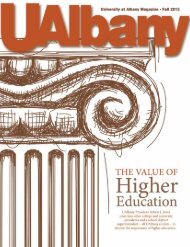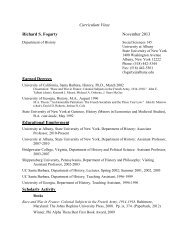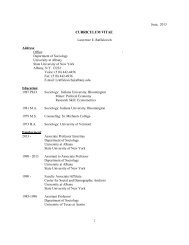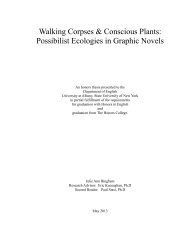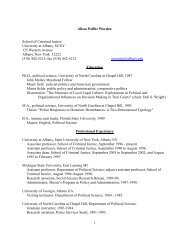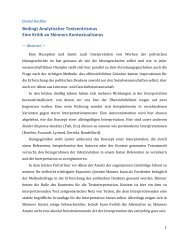Steve Aos - University at Albany
Steve Aos - University at Albany
Steve Aos - University at Albany
Create successful ePaper yourself
Turn your PDF publications into a flip-book with our unique Google optimized e-Paper software.
el<strong>at</strong>ionships <strong>at</strong> the sub-n<strong>at</strong>ional detail. Th<strong>at</strong> is, county prosecutors in Washington St<strong>at</strong>e are likely<br />
to respond to policy changes from Olympia in different ways than prosecutors in Los Angeles<br />
respond to policy changes in Sacramento.<br />
In the second part of his paper, Sabol begins by noting th<strong>at</strong> the first part of the paper “is severely<br />
limited.” He notes th<strong>at</strong> this limit<strong>at</strong>ion surfaces because the decomposition analysis presented in<br />
the first part “cannot address causal issues rel<strong>at</strong>ed to prison popul<strong>at</strong>ion growth even if it can point<br />
out areas for consider<strong>at</strong>ion and research.” Bummer.<br />
The paper proceeds by providing a brief and selected narr<strong>at</strong>ive review of some studies th<strong>at</strong> have, in<br />
turn, summarized the research liter<strong>at</strong>ure on the causal rel<strong>at</strong>ionships between crime and criminal<br />
justice policies. From a policy perspective, the news here is not pretty. These reviews indic<strong>at</strong>e th<strong>at</strong>,<br />
in general, researchers have been unable to contribute precise and convincing estim<strong>at</strong>es of<br />
particular policy options for several reasons. First, researchers in this area have been forced to use<br />
fairly aggreg<strong>at</strong>ed d<strong>at</strong>a because they usually lack individual-level inform<strong>at</strong>ion <strong>at</strong> the point where<br />
actual decisions are made by criminals and criminal justice practitioners. With so much inform<strong>at</strong>ion<br />
unobserved (to researchers), and with random assignment the exception not the rule, it has been<br />
difficult to model rel<strong>at</strong>ionships credibly.<br />
The most significant reason for a weak research base, however, is th<strong>at</strong> criminal justice policies give<br />
every known indic<strong>at</strong>ion of being endogenous. Crime and criminal justice policies appear to be<br />
determined jointly and this has confounded the ability of researchers to identify causal<br />
rel<strong>at</strong>ionships th<strong>at</strong> would otherwise be so useful for setting policies. Sabol notes th<strong>at</strong> the usual<br />
st<strong>at</strong>istical procedures to overcome endogeniety—unassailable instrumental variables—are very<br />
hard to come by in a world where so many things are interrel<strong>at</strong>ed. In concluding the second part of<br />
the paper, Sabol encourages the research community to continue to look for better instruments,<br />
and th<strong>at</strong> it should also look for try to exploit n<strong>at</strong>ural experiments and employ m<strong>at</strong>ching estim<strong>at</strong>ors.<br />
On this last point, it is worth emphasizing th<strong>at</strong>, if more widely used, regression discontinuity<br />
approaches may be able to help identify some causal effects for certain sentencing-rel<strong>at</strong>ed policies.<br />
When st<strong>at</strong>es, such as Washington St<strong>at</strong>e, implement presumptive st<strong>at</strong>ewide sentencing grids, they<br />
are forced to adopt somewh<strong>at</strong> arbitrary cut-points on the particular sanctions received by convicted<br />
offenders. Regression discontinuity designs offer the potential to <strong>at</strong> least identify “local tre<strong>at</strong>ment”<br />
effects around some of these sentencing rules. And, since sentencing grids have many of these<br />
cutoff levels embedded in them, the estim<strong>at</strong>ion of many local tre<strong>at</strong>ment effects offer the potential<br />
to inform a more generalized set of estim<strong>at</strong>es about sentencing. This is a worthy area of future<br />
research, particularly because st<strong>at</strong>es with sentencing grids may often have comprehensive<br />
administr<strong>at</strong>ive d<strong>at</strong>abases with sentencing and conviction d<strong>at</strong>a (because the sanctions for an<br />
offender’s subsequent offenses will typically be a function the current offense and criminal history).<br />
Thus an important part of a n<strong>at</strong>ional research agenda could focus on regression discontinuity<br />
designs in those st<strong>at</strong>es with grid systems and good electronic administr<strong>at</strong>ive d<strong>at</strong>a.<br />
2



